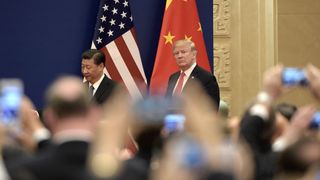Talks between US President Donald Trump and Chinese President Xi Jinping at the G20 summit in Buenos Aires concluded on Saturday night with applause, but no joint statement.
Chinese state television announced that there would be no new tariffs, that negotiations between the two sides would continue, and offered some vague promises on market access. The White House separately released a statement that it would leave existing tariffs in place on $US200 billion ($A273 billion) worth of Chinese goods, but hold off on hiking tariff rates from 10 to 25 per cent and also refrain from placing tariffs on an additional $US267 billion worth of goods imported from China through March 1. The White House also announced that China agreed to purchase an unspecified, but "very substantial" amount of American products. Boarding Air Force One, a White House official commented that talks had gone "very well".
It is important not to overreact to news of continued negotiations, nor mistake this for an end to the trade war.
While this might be welcome news in the short-term for jittery markets, it is important not to overreact to news of continued negotiations, nor mistake this for an end to the trade war.
The deal between China and the United States appears to be a temporary accommodation, rather than an agreement to address fundamental differences.
But regardless of this deal, because friction on core issues of trade and industrial policy will persist between China and most of the advanced economies of the world, it is likely that competition will intensify. This is because the deal is unlikely to resolve any underlying causes. Persistent intellectual property theft, lack of market access, forced technology transfer for foreign firms wanting to work in China, massive subsidies to Beijing's state-owned enterprises are all likely to remain irritants in the larger relationship.
Moreover, Beijing's "China 2025," industrial plan to attempt to dominate the core components of a future economy, while also increasing Chinese acquisitions of US and western firms, will continue to raise concerns that foreign companies will be unable to operate in China, or forced to do business in China under increasingly disadvantageous terms. In this context, an agreement to continue talking is unlikely to moderate an emerging consensus that Beijing is more interested in making rhetorical concessions than in actually adjusting any of its actions.
The deal between China and the United States appears to be a temporary accommodation, rather than an agreement to address fundamental differences.
At its core, the issue is one of fundamentally misaligned objectives. Earlier this week Ely Ratner, a high-ranking official in the Obama administration, wrote that "on most issues of consequence, there is simply no overlap between Xi's vision for China's rise and what the United States considers an acceptable future for Asia and the world beyond". Which is all to say that the underlying dynamics and incentives on both sides will continue the two countries towards economic competition. Trump might have delayed a further escalation of tariffs, but that is more a tactical move meant to reassure American markets, consumers and farmers. Moreover, while tariffs are the most visible tool that Washington has used in its attempt to force Beijing to alter its economic policies, they are not the only means available to the White House, as its use of espionage indictments, financial penalties and tightening of investment scrutiny demonstrate. This is likely to accelerate.
Moving forward, two issues are likely to dominate the policy debate, even if they are both currently in a nascent phase. First, there is gathering policy momentum in Washington to define what responsible decoupling of the American and Chinese economies might look like. The world's two biggest economies cannot easily be unwoven, and their high degree of interdependence precludes wholesale disengagement. But if strategic competition is driving both sides to more warily guard their businesses, their capacity for innovation, and their critical infrastructures, there has been only partial movement to define which sectors, technologies and companies need to be protected and which do not pose a significant risk.
Trump might have delayed a further escalation of tariffs, but that is more a tactical move meant to reassure American markets, consumers and farmers.
Second, as evidence mounts that Xi Jinping has decisively turned away from domestic market reforms and as Chinese labor costs continue their upward trend, there will be growing appetite to move supply-chain sourcing away from China and towards alternative manufacturing outlets in Southeast Asia and beyond. Of course, despite Trump's claims that China's loss would be America's gain, most economists predict that manufacturing would move to other countries in Asia capable of producing higher and lower-end products at more competitive cost, rather than systematic on-shoring of manufacturing in America. The unanswered question however, is whether gains for companies that move their manufacturing to other countries will offset likely losses they might incur from losing China-centred trade.
Beijing may once have thought that all it had to do was find ways to reduce its deficit and Trump would agree to a deal. But beneath the good feelings and smiles of Saturday's dinner, the announcement that US tariffs could both increase and be applied to more goods on March 1 absenting substantive Chinese market reforms, underscores the point that in the long run Washington wants more than simply a reduction in the trade imbalance. Unless Beijing begins upholding its commitments and making fundamental adjustments to its economic behaviour, this deal will likely only be a temporary reprieve.






